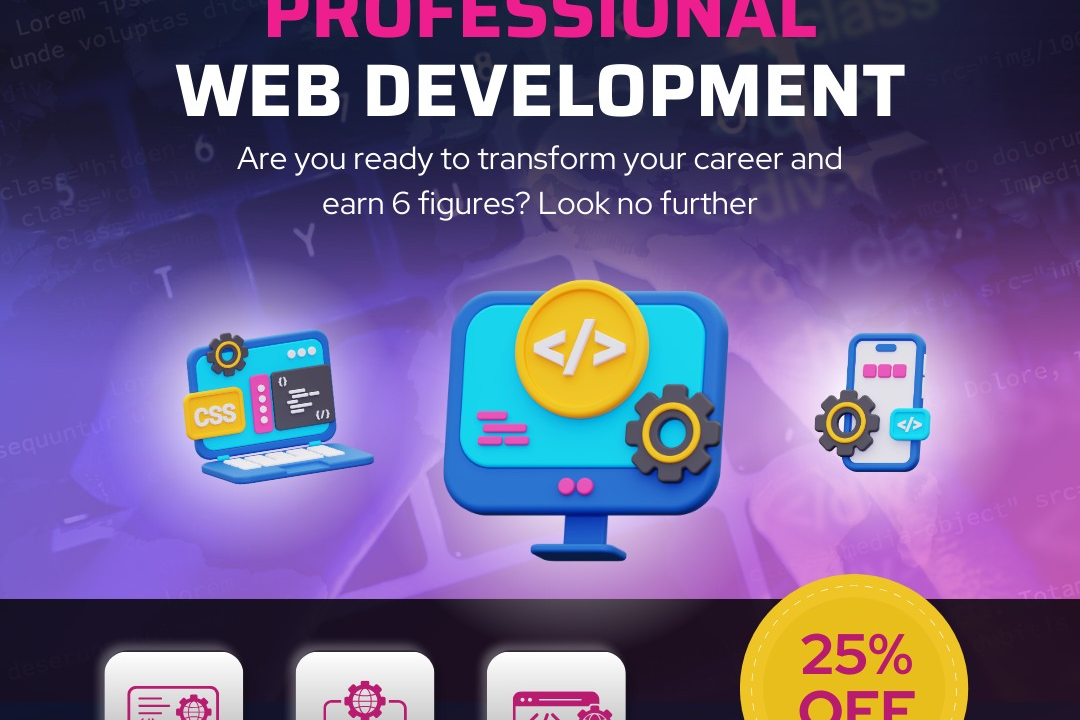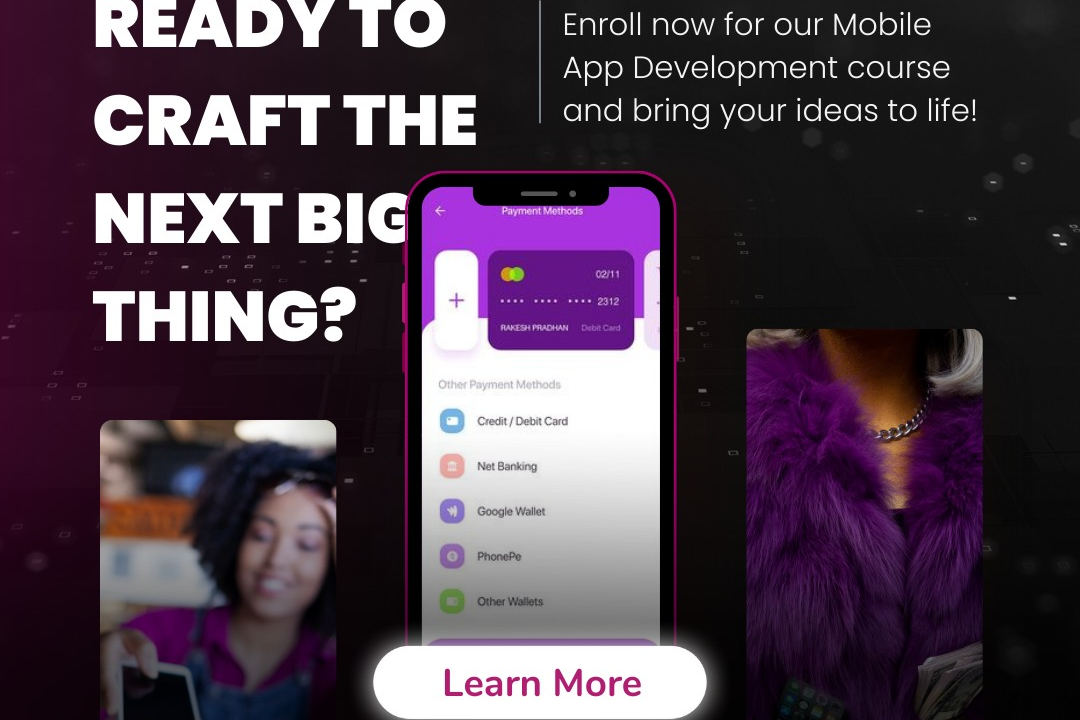Free Online Training PHP Programming
Our free online PHP programming training at JustAcademy provides comprehensive instruction on buildi
Free Online Training PHP Programming
Our free online PHP programming training at JustAcademy is a valuable resource for aspiring developers looking to build dynamic websites and web applications. It provides practical skills in server-side scripting, enabling learners to create interactive and efficient web solutions. With hands-on projects and real-world examples, this course helps you gain industry-relevant experience, making it easier to kickstart your career in web development—all at no cost.
To Download Our Brochure: https://www.justacademy.co/download-brochure-for-free
Message us for more information: +91 9987184296
Our free online PHP programming training at JustAcademy is a valuable resource for aspiring developers looking to build dynamic websites and web applications. It provides practical skills in server side scripting, enabling learners to create interactive and efficient web solutions. With hands on projects and real world examples, this course helps you gain industry relevant experience, making it easier to kickstart your career in web development—all at no cost.
Course Overview
The Free Online PHP Programming Training at JustAcademy offers practical, hands-on instruction in server-side scripting, covering core concepts, syntax, and real-world project development to help learners build dynamic websites and enhance their web development skills.
Course Description
Join JustAcademy's Free Online PHP Programming Training to gain essential server-side scripting skills through hands-on projects, covering core syntax, database integration, and dynamic web development techniques to kickstart your career in web development.
Key Features
1 - Comprehensive Tool Coverage: Provides hands-on training with a range of industry-standard testing tools, including Selenium, JIRA, LoadRunner, and TestRail.
2) Practical Exercises: Features real-world exercises and case studies to apply tools in various testing scenarios.
3) Interactive Learning: Includes interactive sessions with industry experts for personalized feedback and guidance.
4) Detailed Tutorials: Offers extensive tutorials and documentation on tool functionalities and best practices.
5) Advanced Techniques: Covers both fundamental and advanced techniques for using testing tools effectively.
6) Data Visualization: Integrates tools for visualizing test metrics and results, enhancing data interpretation and decision-making.
7) Tool Integration: Teaches how to integrate testing tools into the software development lifecycle for streamlined workflows.
8) Project-Based Learning: Focuses on project-based learning to build practical skills and create a portfolio of completed tasks.
9) Career Support: Provides resources and support for applying learned skills to real-world job scenarios, including resume building and interview preparation.
10) Up-to-Date Content: Ensures that course materials reflect the latest industry standards and tool updates.
Benefits of taking our course
Functional Tools
1 - Integrated Development Environments (IDEs): The training utilizes popular IDEs like PHPStorm, Visual Studio Code, and Sublime Text, which provide a user friendly interface for writing, debugging, and managing PHP code. These tools enhance productivity through features like syntax highlighting, code suggestions, and integrated debugging, making it easier for students to develop and test their projects efficiently. Familiarity with these IDEs prepares learners for real world development environments and coding standards.
2) Version Control Systems (Git): Students are introduced to Git, a vital tool for collaborative coding and project management. It helps track changes in code, revert to previous versions, and collaborate smoothly with team members on complex projects. The course covers basic Git commands and workflows like branching and merging, fostering good practices in code management and teamwork in software development.
3) Local Server Environment: Tools such as XAMPP, WAMP, and MAMP are utilized to set up local development servers. These platforms allow students to run PHP scripts locally on their computers, simulating a live web server environment. This is essential for testing dynamic web pages and database interactions without the need for internet hosting, providing hands on experience in server configuration and deployment processes.
4) Database Management Tools: The course incorporates PHPMyAdmin and MySQL Workbench for database management. These tools enable students to create, modify, and query databases that interact with PHP applications. Learning to work with databases is crucial for developing data driven web applications, and these tools facilitate an intuitive understanding of SQL commands, database design, and data retrieval techniques.
5) Web Browsers for Testing: Modern web browsers like Google Chrome, Mozilla Firefox, and Microsoft Edge are used extensively for testing PHP based websites. Students learn to inspect code, debug front end issues, and monitor network activity. Browser developer tools aid in understanding how PHP interacts with HTML, CSS, and JavaScript, enhancing debugging and optimization skills essential for full stack development.
6) Command Line Interface (CLI): The course emphasizes the importance of using terminal or command prompt for executing PHP scripts and managing server environments. CLI skills enable students to automate tasks, run scripts quickly, and perform server configurations efficiently. Exposure to the command line also develops troubleshooting skills and a better understanding of underlying server operations.
7) Code Collaboration and Sharing Platforms: Platforms like GitHub and GitLab are introduced for sharing code repositories, collaborating with peers, and showcasing projects. They provide a version controlled environment for students to manage their codebase, partner with others on coding exercises, and build a professional portfolio. Familiarity with these platforms is vital for open source contributions and remote teamwork.
8) Learning Management Systems (LMS): The training platform itself often incorporates LMS tools that deliver course content, quizzes, and assessments. These tools help track progress, facilitate communication with instructors, and provide a structured learning pathway, ensuring students stay engaged and organized throughout their PHP programming journey.
9) Debugging Tools and Plugins: Specific debugging tools like Xdebug for PHP are used to identify errors and optimize code. Integrated into IDEs, these tools speed up the debugging process by allowing step by step code execution, variable inspection, and call stack analysis. Mastering debugging techniques improves code quality and reduces development time.
10) Code Editors with Extensions: Besides IDEs, students use lightweight code editors like Visual Studio Code with extensions for PHP linting, code formatting, and syntax checking. These tools streamline coding practices, enforce standards, and minimize errors, contributing to cleaner and more maintainable codebases.
11 - Front End Development Tools: To complement PHP, the course introduces Bootstrap, jQuery, and other HTML/CSS/JavaScript frameworks through code editors and live preview tools. These tools help students craft responsive and interactive web pages that integrate seamlessly with PHP back end logic, providing a full stack development experience.
12) Automated Testing Tools: PHPUnit and other testing frameworks are incorporated to help students write unit tests for PHP code. These tools promote test driven development, improve reliability, and help in debugging by catching issues early, ensuring code robustness and stability.
13) Project Management Tools: Tools like Trello or Jira are suggested for organizing project workflows, tracking tasks, and collaborating in teams. Utilizing these platforms cultivates good project management habits, prepares students for agile methodologies, and helps in managing multiple projects efficiently.
14) Cloud Storage Platforms: Google Drive, Dropbox, or OneDrive are used for sharing resources, storing project files, and collaborating remotely. These tools encourage effective file management and provide a centralized space for project assets, making remote learning seamless and organized.
15) Security and Compliance Tools: Basic encryption tools and security plugins are part of the course to teach safe coding practices. Understanding how to secure PHP applications against threats like SQL injection and cross site scripting (XSS) is critical, and these tools facilitate hands on learning about web security measures.
16) Containerization Tools (Docker): The course introduces Docker to teach students how to create, deploy, and run PHP applications within containerized environments. This promotes consistency across development, staging, and production setups, and helps students understand modern deployment practices, microservices architecture, and environment management.
17) Continuous Integration/Continuous Deployment (CI/CD) Tools: Platforms like Jenkins, Travis CI, or GitHub Actions are discussed to demonstrate automated testing, building, and deployment processes. These tools prepare students for industry standards in DevOps workflows, ensuring smoother integration and quicker product releases.
18) Performance Profiling Tools: Tools like XHProf or Blackfire are used to analyze and optimize PHP code performance. Students learn to identify bottlenecks, optimize database queries, and improve application speed, which is vital for developing scalable and efficient web applications.
19) Code Documentation Tools: Utilizing tools like PHPDoc helps students learn to write clear, professional, and maintainable code documentation. Proper documentation is essential for team collaboration, code readability, and long term project maintenance.
20) Cross Browser Compatibility Testing Tools: Using platforms like BrowserStack or Sauce Labs, students verify that PHP based web applications function correctly across various browsers and devices. This ensures consistent user experience and broad accessibility of their projects.
21 - API Testing Tools: Postman and Swagger are used to teach students how to interact with and test APIs. Learning API documentation, testing, and integration prepares students for developing and consuming web services, which are integral to modern applications.
22) Static Code Analysis Tools: Tools like PHP_CodeSniffer and PHPMD (PHP Mess Detector) help identify coding standard violations and potential code smells. These promote best coding practices, improve code quality, and ensure adherence to industry standards.
23) Learning and Practice Platforms: Online coding platforms like Codecademy, HackerRank, or LeetCode are integrated into the curriculum for practice and skill enhancement. They provide additional hands on experience and problem solving opportunities, complementing project based learning.
24) Web Security Testing Tools: OWASP ZAP or Burp Suite are discussed to teach students about web application security testing. Understanding common vulnerabilities and mitigation techniques is essential for developing secure PHP applications.
25) Performance Monitoring and Analytics Tools: Tools like New Relic or Datadog are introduced for monitoring live applications' performance. Students learn to track application metrics, troubleshoot issues in real time, and optimize user experience.
26) Content Delivery Network (CDN) Integration: The course explores how to integrate CDNs like Cloudflare or Akamai for faster content delivery. Learning how to utilize CDNs helps students build high performance websites suitable for large scale traffic.
27) Accessibility Testing Tools: Tools like WAVE or Axe assist students in ensuring that their PHP web applications are accessible to users with disabilities. Promoting inclusive design improves overall user experience and reaches a broader audience.
28) Responsive Design Testing: Using tools like Responsinator or Google’s Mobile Friendly Test, students verify that their websites are responsive across device sizes. This ensures that applications provide a seamless experience on desktops, tablets, and smartphones.
29) Localization and Internationalization Tools: Tools and techniques for adapting applications for different languages and regions are covered. This broadens students' understanding of creating globally accessible applications.
30) Documentation and Versioning Platforms: Besides version control, tools like Confluence or Notion are introduced for collaborative documentation creation and knowledge sharing. These platforms facilitate team coordination, especially in larger projects.
31 - Learning Management and Certification Platforms: The course leverages LMS integrations for progress tracking, quizzes, and certifications, reinforcing learning outcomes and providing industry recognized accreditation from JustAcademy.
32) Cloud Service Provider Platforms: Introduction to AWS, Google Cloud, or Azure enables students to deploy PHP applications in cloud environments, gaining practical skills in cloud hosting, management, and scalability.
33) Automated Backup Solutions: Teaching students about automated data backup tools ensures the safety and recovery of project data, emphasizing best practices in data security and business continuity.
34) Front End Framework Integration Tools: Incorporating frameworks like Vue.js or React with PHP backend exposes students to full stack development, emphasizing modern web application architecture.
35) API Security Tools: Implementing API security measures using OAuth, API keys, and rate limiting demonstrates secure API development and consumption practices, essential for safeguarding sensitive data.
36) Real Time Communication Tools: Utilizing WebSocket libraries and chat API integrations enables students to build real time features like chat or notifications, enhancing interactive web application skills.
37) Licensing and Compliance Management Tools: Teaching about open source licenses and compliance tools ensures that students understand legal considerations in software development and distribution.
38) Collaborative Project Platforms: Tools like Slack or Microsoft Teams are used for real time communication and collaboration, simulating professional work environments and improving teamwork skills.
39) Data Visualization Libraries: Incorporating libraries like Chart.js or D3.js allows students to present data insights graphically, enriching PHP driven data presentation and analysis capabilities.
40) Learning Path Customization Tools: Platforms offering personalized learning tracks enable students to focus on specific career goals, providing tailored skill development aligned with industry demands.
Browse our course links : https://www.justacademy.co/all-courses
To Join our FREE DEMO Session:
This information is sourced from JustAcademy
Contact Info:
Roshan Chaturvedi
Message us on Whatsapp: +91 9987184296
Email id: info@justacademy.co
Aspire Systems Interview Questions For Freshers For Php Developer











